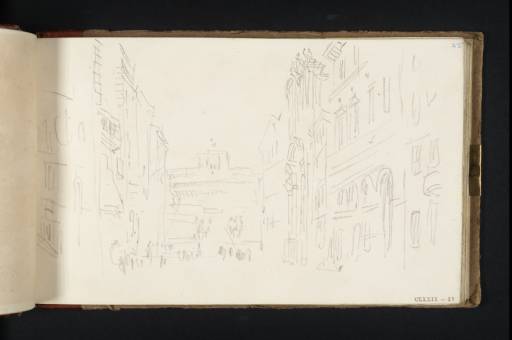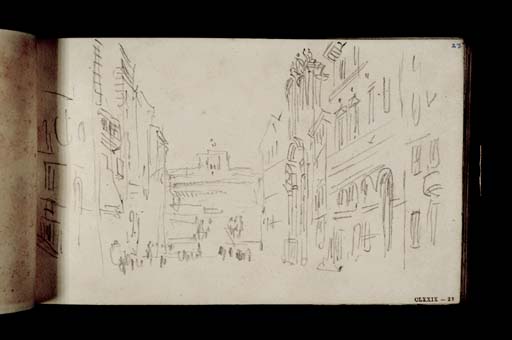Joseph Mallord William Turner Castel Sant'Angelo, Rome, Seen from the Church of Santi Celsi e Giuliano 1819
Image 1 of 2
Joseph Mallord William Turner,
Castel Sant'Angelo, Rome, Seen from the Church of Santi Celsi e Giuliano
1819
Joseph Mallord William Turner 1775–1851
Folio 23 Recto:
Castel Sant’Angelo, Rome, Seen from the Church of Santi Celsi e Giuliano 1819
D14968
Turner Bequest CLXXIX 23
Turner Bequest CLXXIX 23
Pencil on white wove paper, 112 x 186 mm
Inscribed by ?John Ruskin in blue ink ‘23’ top right
Stamped in black ‘CLXXIX 23’ bottom right
Inscribed by ?John Ruskin in blue ink ‘23’ top right
Stamped in black ‘CLXXIX 23’ bottom right
Accepted by the nation as part of the Turner Bequest 1856
References
1909
A.J. Finberg, A Complete Inventory of the Drawings of the Turner Bequest, London 1909, vol.I, p.527 as ‘Street, with castle of St. Angelo’.
1987
Robert E. McVaugh, ‘Turner and Rome, Raphael and the Fornarina’, Studies in Romanticism, no.26, Autumn 1987, p.372.
The vast size, striking shape and prominent location of the Castel Sant’Angelo, located on the banks of the Tiber near St Peter’s and the Vatican, make the castle one of the most prominent landmarks in Rome. Originally the mausoleum of the Emperor Hadrian, the cylindrical building dates from AD 139 but was later converted from a tomb to a fortress, acting as part of the military defenses of the city until the end of the nineteenth century. The name derives from a legendary vision of the Archangel Michael who reportedly appeared above the building sheathing his sword as a symbol of the end of a great plague in 590 AD. Since 1753, a massive bronze statue of the angel by the Flemish sculptor Peter Anton Verschaeffelt (1710–93) has crowned the top, replacing an earlier one in marble by Raffaelo da Montelupo (circa 1504/5–circa 1566/7). The castle is linked across the Tiber to the centre of the city by the Ponte Sant’Angelo, a bridge built by Hadrian and formerly known as the Pons Aelius.
This sketch depicts the Castel Sant’Angelo from Via del Banco di Santo Spirito, part of a Papal thoroughfare which links St Peter’s with San Giovanni in Laterano. Turner’s location is a point near the eighteenth-century Church of Santi Celso e Giuliano, visible on the right, looking north towards the southern end of Ponte Sant’Angelo and the front of the castle. Further views can be found on folios 22 and 26 verso (D14967 and D14973), as well as in the St Peter’s sketchbook (Tate D16215 and D16216; Turner Bequest CLXXXVIII 33a and 34); the Rome: C. Studies sketchbook (Tate D16336 and D16358; Turner Bequest CLXXXIX 10 and 32); and the Small Roman C. Studies sketchbook (Tate D16405; Turner Bequest CXC 9). The Castel Sant’Angelo also forms the subject for two vignette watercolour illustrations related to literary projects: Rome, Castle of St. Angelo for Rogers’s Italy, circa 1826–7 (see Tate D27677; Turner Bequest CCLXXX 160); and The Castle of St. Angelo for Byron’s Life and Works, circa 1832 (Tate, N05243).
Verso:
Blank
Blank
Nicola Moorby
January 2010
How to cite
Nicola Moorby, ‘Castel Sant’Angelo, Rome, Seen from the Church of Santi Celsi e Giuliano 1819 by Joseph Mallord William Turner’, catalogue entry, January 2010, in David Blayney Brown (ed.), J.M.W. Turner: Sketchbooks, Drawings and Watercolours, Tate Research Publication, December 2012, https://www


